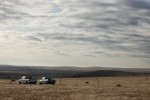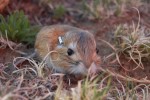As the Shortgrass Steppe (SGS) Long Term Ecological Research (LTER) funding from the National Science Foundation (NSF) ends, it is a good time to reflect upon the trajectory of the project. Over the past nine months, we have conducted over 30 interviews with people associated with the SGS-LTER project as part of a study entitled The biography of the SGS-LTER: The science stories behind the data. The effort is supported with supplement funds for information management from The U.S. National Science Foundation, and research funds from the Academy of Finland and the Research Council of University of Oulu.
As part of this effort, the SGS-LTER information management team and Principal Investigators (PIs) are also preparing data and metadata packages for the LTER Network’s Provenance Aware Synthesis Tracking Architecture (PASTA) framework and collecting stories that provide a richer context for the products from SGS research.
For our study we took advantage of the huge gathering of scientists at the All Scientists Meeting in September 2012 to collect data through interviews with scientists who had worked on the SGS-LTER site at some point. During follow up visits to the SGS research site and the home institution at Colorado State University (CSU), we conducted more interviews and group sessions with local SGS scientists, staff and alumni. When Karasti returned to Finland, Kaplan continued to conduct interviews with research partners at the US Department of Agriculture’s Agricultural Research Service, who manage the Central Plains Experimental Range (CPER) research site in Nunn, Colorado, where the International Biome Program (IBP), an important predecessor of the LTER Network, was once headquartered and which hosts a number of core SGS-LTER experiments. Karasti returned to Colorado in late April 2013, to continue data collection with members of the Crow Valley Livestock Grazing Association, long-term stakeholders in the USDA-ARS and LTER. We then extended the interviews to more administrative groups, such as our funding organizations, the CSU administration, and LTER Network administrators.
We have coded and are currently analyzing the interview transcripts to capture and synthesize the stories of people, and to identify emergent themes related to site-based, long-term, collaborative research at the SGS-LTER. We will continue the joint analysis and writing articles when Kaplan visits Finland in summer 2013.
Interesting insights are emerging from this effort. Stories that relate the history of LTER research portray deep roots in IBP and ecosystems thinking. SGS was one of the first sites in the LTER Network, established in 1982. The first PIs at the SGS-LTER were post-docs and early career researchers working on IBP; their approaches to studying the shortgrass steppe were shaped by their experiences in the previous project.
SGS-LTER PIs’ contributions to the Network are indispensable: conducting cross-site and synthesis work, expanding and extrapolating research to regional scales, creating and sharing adaptable biogeochemical, land-atmospheric and spatially explicit models, and building network-wide K-12 schoolyard and other educational programs. Today, a new generation of scientists and educators are following up and building upon the work of these first LTER PIs, applying innovative techniques to study in more depth issues such as the complex relationships within ecosystems and the impacts of climate change.
As participants share their experiences from different perspectives and points in time, their narratives describe the fun and challenges of growing research teams, applying and testing new methods across sites, and expanding scientific frameworks to include new dynamics and organisms. Recurrent themes include science leadership for interdisciplinary teams as a complex practice of many balances, collaborative research over the different phases involved in a long term project, and the importance of having dependable support to maintain and innovate our science, education and outreach programs
Interviewees have also shared with us emotional and operational responses to the decommissioning of the SGS-LTER program. We have learned that the reach and ramifications of the termination of an LTER site go well beyond the initially foreseen tasks such as taking down experiments in the field and preparing data packages for archival. Scientists expressed a need for a strategy to continue investigating existing and new questions in a coordinated fashion and an opportunity to continue collecting long term data for some core studies. In the absence of a centralized framework and support from LTER, there are challenges to maintaining formal collaborations and updating datasets and metadata available through the LTER Network Information System in the future.
Nevertheless, the SGS site is an important long-term grassland site in the middle of the diagonal gradient across the North American Great Plains. It represents a threatened habitat for biodiversity and continues to host large collaborative research programs, such as the National Ecological Observatory Network (NEON) and Long Term Agroecological Research (LTAR) programs. The SGS program’s longstanding membership of LTER site and ongoing research activities also raises questions about how the site will be represented within LTER databases and websites, and how the site and the Network may continue to leverage each other when responding to requests for proposals and other information.
The SGS-LTER program is an example of how a long-term research effort can afford access to deeper understanding of place-based research at a particular site. Unfortunately, this knowledge can be lost and succeeding generations of researchers may have to re-learn the lessons—unless care is taken, as in the present effort, to preserve that knowledge. In the three decades of U.S. LTER Program’s existence, three projects have lost their funding; however, none of their lessons-learned passed on. Our interviews with scientists, staff, students, ranchers, and other stakeholder groups associated with SGS-LTER have evoked diverse views and accounts of work and research on the shortgrass steppe that will contribute to preserving the legacy of the SGS-LTER project, including how to manage the end.
Nicole Kaplan is the SGS-LTER Information Manager and Helena Karasti is an interdisciplinary scholar based at the University of Oulu, Finland, and the Luleå University of Technology, Sweden, and a member of the Finnish Long-Term Socio-Ecological Research (FinLTSER) Network.

 Enlarge this image
Enlarge this image


